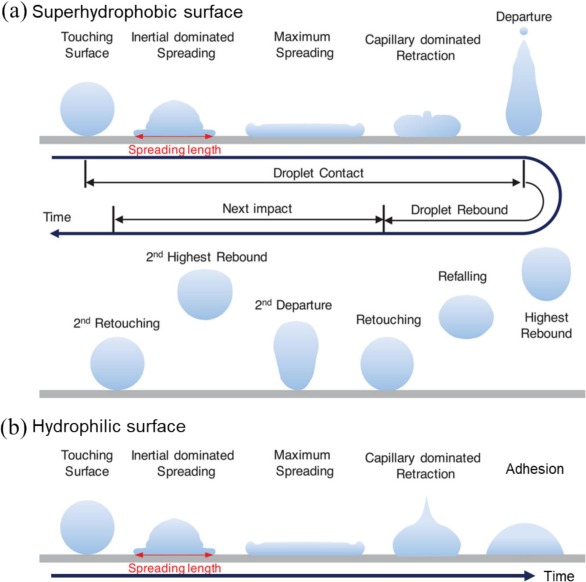
If you have ever observed water droplets skimming across a heated pan, you have seen a brief instance of physics wonder. Now, scientists at Switzerland’s EPFL have managed to make tiny oil droplets bounce on a vibrating solid surface for as long as five minutes, and potentially indefinitely.
This finding builds on the Leidenfrost effect, wherein liquid droplets float on their own vapor cushion above extremely hot surfaces. However, here’s the catch: no heat is necessary. The researchers substituted the thermal cushion with mechanical vibrations, causing droplets to dance at room temperature on an atomically smooth mica sheet.
“What’s intriguing here is that prior observations of continuously bouncing droplets were influenced by the shifting surface of the vibrating liquid bath, but in our scenario, the surface is solid, so the drop’s own distortions dictate its exceptional behavior,” states John Kolinski, who leads EPFL’s Engineering Mechanics of Soft Interfaces Lab.
Two Methods of Bouncing
The research group, guided by PhD student Lebo Molefe, found something surprising: droplets display two different behaviors based on vibration frequency. At moderate frequencies, droplets bounce like miniature basketballs, visibly leaping above the surface. Increase the frequency, and the droplets transition into what researchers refer to as a “bound state,” where they seem glued to the surface while vibrating intensely in place.
The transition point? When vibrations reach around 100 cycles per second, matching the droplet’s natural resonance frequency. Below this threshold, droplets capture energy like coiled springs, flattening against the air cushion before springing upwards. Above this point, they vibrate so quickly that they cannot accumulate enough elastic energy to achieve a proper bounce.
Molefe likens the experiment to keeping a ping-pong ball bouncing on a paddle, with the ball being liquid and the paddle being vibrating mica, a mineral so smooth that its surface varies by only a few nanometers. The 1.6-millimeter silicon oil droplets float on an air film so thin it is almost imperceptible, maintained solely by the interplay between surface tension and mechanical vibration.
Mathematics Meets Microfluidics
To understand the physics behind these levitating droplets, researcher Tomas Fullana created computer simulations that followed every wobble and deformation. The team discovered they could anticipate droplet behavior using a relatively straightforward model: two coupled springs representing the droplet’s center of mass and its shape oscillations.
“To ‘jump off’ the surface, the drop requires enough time to flatten first, allowing surface tension to enable it to store energy like a spring. At high vibration frequencies, there isn’t enough time for this process to occur, resulting in the drop appearing stuck near the surface.”
The simulations uncovered something interesting: droplets could theoretically bounce endlessly, only constrained by imperfections in the surface. In reality, droplets ultimately encountered microscopic flaws in the mica that disrupted the air cushion, causing them to splat. On an ideally smooth surface, the mechanical energy from vibrations would precisely counterbalance energy lost to friction.
The researchers broke down the droplet shapes into mathematical elements known as spherical harmonics, similar to disassembling a musical chord into individual notes. They found that the second harmonic mode, which causes droplets to alternate between pancake and football shapes, is vital for continued bouncing. When this mode is properly excited, droplets can lift off the surface. Conversely, when higher modes dominate, droplets become trapped.
“Our numerical simulations demonstrate that a drop could maintain enough kinetic energy to bounce for an extended duration, potentially indefinitely.”
These findings may transform how scientists manipulate tiny liquid amounts in pharmaceutical production, where chemical purity and accuracy are crucial. The EPFL team has already shown their ability to direct bouncing droplets across the mica surface using tiny streams of compressed air, akin to pneumatic tweezers for liquids.
Unlike the Leidenfrost effect, which necessitates temperatures high enough to vaporize liquid and could harm sensitive molecules, vibration-based levitation functions at room temperature. The droplets traverse the surface significantly faster than they would on a liquid bath, and the solid substrate provides much greater control than a rippling fluid surface.
What began as a curiosity regarding bouncing droplets has unveiled fundamental physics about how liquids interact with solids when contact is avoided. The researchers documented their findings in Physical Review Letters, along with mathematical models predicting droplet trajectories without any adjustable parameters, a notable achievement in fluid dynamics.
Physical Review Letters: [10.1103/w3qq-cnj3](https://doi.org/10.1103/w3qq-cnj3)
There’s no paywall here
If our reporting has educated or inspired you, please consider making a donation. Every contribution, regardless of size, allows us to continue providing accurate, engaging, and trustworthy science and medical news. Independent journalism demands time, effort, and resources—your support ensures we can keep revealing the stories that matter most to you.
Join us in making knowledge accessible and meaningful. Thank you for being with us!